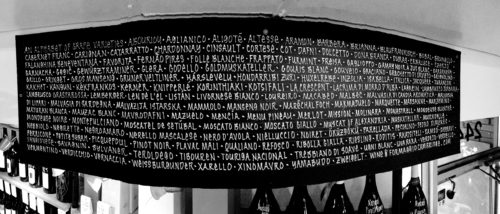 The chalkboard that hangs over our wine corner shelves lists a hundred or so lesser-known grapes from which wine is made today. It stands as a tediously hand-lettered warning to those who believe a passing familiarity with Chardonnay, Sauvignon Blanc, Pinot Noir and Merlot punches their ticket into the fellowship of wine know-somethings. But even if you were on intimate terms with every cultivar posted there, you would still be far short of a comprehensive knowledge of wine grape varieties. The most authoritative English language ampelographical resource in print* identifies no less than 1,380 as currently in use somewhere in the world. Why so many?
The chalkboard that hangs over our wine corner shelves lists a hundred or so lesser-known grapes from which wine is made today. It stands as a tediously hand-lettered warning to those who believe a passing familiarity with Chardonnay, Sauvignon Blanc, Pinot Noir and Merlot punches their ticket into the fellowship of wine know-somethings. But even if you were on intimate terms with every cultivar posted there, you would still be far short of a comprehensive knowledge of wine grape varieties. The most authoritative English language ampelographical resource in print* identifies no less than 1,380 as currently in use somewhere in the world. Why so many?
It’s simple, really. Each vine carries some of the DNA of its parents (including the DNA of its parent’s parents and its parent’s parents’ parents) and thus every plant produced from seed will resemble its parent vine – but will not reproduce it precisely. Like human children, each will be unique. Thus, you can’t be sure to see all a parent’s admirable qualities faithfully reproduced in its progeny. As you may have guessed, the operative phrase here is produced from seed.Wine-growers have known since ancient times that the only sure way to preserve and pass on the good qualities of a healthy, productive vine is by means of asexual reproduction.
To accomplish this, it’s necessary to forego propagation from seed and instead create a new vine by grafting a cutting from the parent vine onto an existing root or trunk, or, alternatively, resort to an ancient trick still in favor among many naturalist winemakers: pull a bearing cane down to the ground and bury a portion of it, where it will root. Once established, you merely cut the connection to the parent plant and you’ve got a vine baby that’s a perfect genetic copy of its parent. No botanical canoodling whatever involved.
Today, plant scientists have various ways of supervising plant sex to try to create new vines that emphasize desirable qualities and tamp down those less welcome. Once a useful new vine is created, the way to make sure it doesn’t move around on you is to supervise its clonal propagation in nurseries. What this means to you, budding wine know-something, is that once you’ve painstakingly learned all 1,380 grape varieties and their idiosyncrasies, you can start sorting out the various clonal sub-varietals of each. Chardonnay and Pinot Noir alone have scores of them.
Conclusion: You’re going to need a bigger chalkboard.
– Stephen Meuse
This week in the wine corner . . .
THURSDAY, JANUARY 24 3-6 PM – WHERE VINE BABIES COME FROM
Óscar Olmos, “La Princesa” Jumilla, $19.95
Montemelino, Colli del Trasimeno Rosso, $19.95
FRIDAY, JANUARY 25 3-6 PM – NO SEX, PLEASE. WE’RE CLONAL
Punta Crena, Riviera Ligure di Ponente Vermentino, $22.95
Punta Crena, Riviera Ligure di Ponente Rossese, $23.95